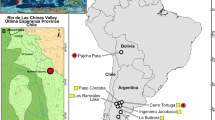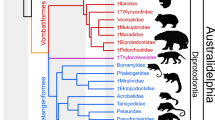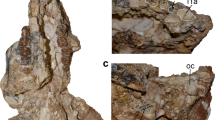Abstract
With the discovery of Ardipithecus, Orrorin and Sahelanthropus1,2,3,4,5,6,7, our knowledge of hominid evolution before the emergence of Pliocene species of Australopithecus8,9 has significantly increased, extending the hominid fossil record back to at least 6 million years (Myr) ago. However, because of the dearth of fossil hominoid remains in sub-Saharan Africa spanning the period 12–7 Myr ago, nothing is known of the actual timing and mode of divergence of the African ape and hominid lineages. Most genomic-based studies suggest a late divergence date—5–6 Myr ago and 6–8 Myr ago for the human–chimp and human–gorilla splits, respectively10,11,12,13,14—and some palaeontological and molecular analyses hypothesize a Eurasian origin of the African ape and hominid clade15,16. We report here the discovery and recognition of a new species of great ape, Chororapithecus abyssinicus, from the 10–10.5-Myr-old deposits of the Chorora Formation at the southern margin of the Afar rift. To the best of our knowledge, these are the first fossils of a large-bodied Miocene ape from the African continent north of Kenya. They exhibit a gorilla-sized dentition that combines distinct shearing crests with thick enamel on its ‘functional’ side cusps. Visualization of the enamel–dentine junction by micro-computed tomography reveals shearing crest features that partly resemble the modern gorilla condition. These features represent genetically based structural modifications probably associated with an initial adaptation to a comparatively fibrous diet. The relatively flat cuspal enamel–dentine junction and thick enamel, however, suggest a concurrent adaptation to hard and/or abrasive food items. The combined evidence suggests that Chororapithecus may be a basal member of the gorilla clade, and that the latter exhibited some amount of adaptive and phyletic diversity at around 10–11 Myr ago.
This is a preview of subscription content, access via your institution
Access options
Subscribe to this journal
Receive 51 print issues and online access
$199.00 per year
only $3.90 per issue
Buy this article
- Purchase on Springer Link
- Instant access to full article PDF
Prices may be subject to local taxes which are calculated during checkout



Similar content being viewed by others
References
White, T. D., Suwa, G. & Asfaw, B. Australopithecus ramidus, a new species of early hominid from Aramis, Ethiopia. Nature 371, 306–312 (1994)
Semaw, S. et al. Early Pliocene hominids from Gona, Ethiopia. Nature 433, 301–305 (2005)
Haile-Selassie, Y. Late Miocene hominids from the Middle Awash, Ethiopia. Nature 412, 178–181 (2001)
Haile-Selassie, Y., Suwa, G. & White, T. D. Late Miocene teeth from Middle Awash, Ethiopia, and early hominid dental evolution. Science 303, 1503–1505 (2004)
Senut, B. et al. First hominid from the Miocene (Lukeino Formation, Kenya). C. R. Acad. Sci. (Paris) 332, 137–144 (2001)
Brunet, M. et al. A new hominid from the Upper Miocene of Chad, Central Africa. Nature 418, 145–151 (2002)
Brunet, M. et al. New material of the earliest hominid from the Upper Miocene of Chad. Nature 434, 752–755 (2005)
White, T. D. et al. Asa Issie, Aramis and the origin of Australopithecus. Nature 440, 883–889 (2006)
Kimbel, W. H. et al. Was Australopithecus anamensis ancestral to A. afarensis? A case of anagenesis in the hominin fossil record. J. Hum. Evol. 51, 134–152 (2006)
Horai, S., Hayasaka, K., Kondo, R., Tsugane, K. & Takahata, N. Recent African origin of modern humans revealed by complete sequences of hominoid mitochondrial DNAs. Proc. Natl Acad. Sci. USA 92, 532–536 (1995)
Chen, F.-C. & Li, W.-H. Genomic divergences between humans and other hominoids and the effective population size of the common ancestor of humans and chimpanzees. Am. J. Hum. Genet. 68, 444–456 (2001)
Stauffer, R. L., Walker, A., Ryder, O. A., Lyons-Weiler, M. & Hedges, S. B. Human and ape molecular clocks and constraints on paleontological hypotheses. J. Hered. 92, 469–474 (2001)
Glazko, G. V. & Nei, M. Estimation of divergence times for major lineages of primate species. Mol. Biol. Evol. 20, 424–434 (2003)
Kumar, S., Filipski, A., Swarna, V., Walker, A. & Hedges, S. B. Placing confidence limits on the molecular age of the human–chimpanzee divergence. Proc. Natl Acad. Sci. USA 102, 18842–18847 (2005)
Stewart, C.-B. & Disotell, T. R. Primate evolution — in and out of Africa. Curr. Biol. 8, R582–R588 (1998)
Begun, D. R. Sivapithecus is east and Dryopithecus is west, and never the twain shall meet. Anthropol. Sci. 113, 53–64 (2005)
Geraads, D., Alemseged, Z. & Bellon, H. The late Miocene mammalian fauna of Chorora, Awash basin, Ethiopia: systematics, biochronology and the 40K–40Ar ages of the associated volcanics. Tertiary Res. 21, 113–122 (2002)
Sickenberg, O. & Schönfeld, M. in Afar Depression of Ethiopia (eds Pilger, A. & Rösler, A.) 277–284 (Schweizerbart, Stuttgart, 1975)
Kunz, K., Kreuzer, H. & Müller, P. in Afar Depression of Ethiopia (eds Pilger, A. & Rösler, A.) 370–374 (Schweizerbart, Stuttgart, 1975)
Tiercelin, J.-J., Michaux, J. & Bandet, Y. Le Miocène supérieur du Sud de la Dépression de ľAfar, Ėthiopia: sédiments, faunas, âges isotopiques. Bull. Soc. Geol. Fr. 21, 255–258 (1979)
Bernor, R. L., Kaiser, T. M. & Nelson, S. V. The oldest Ethiopian hipparion (Equinae, Perissodactyla) from Chorora: Systematics, paleodiet and paleoclimate. Courier Forschungsinst. Senckenberg 246, 213–226 (2004)
Pickford, M. & Kunimatsu, Y. Catarrhines from the Middle Miocene (ca. 14.5 Ma) of Kipsaraman, Tugen Hills, Kenya. Anthropol. Sci. 113, 189–224 (2005)
Jernvall, J., Keränen, S. V. E. & Thesleff, I. Evolutionary modification of development in mammalian teeth: Quantifying gene expression patterns and topography. Proc. Natl Acad. Sci. USA 97, 14444–14448 (2000)
Kangas, A. T., Evans, A. R., Thesleff, I. & Jernvall, J. Nonindependence of mammalian dental characters. Nature 432, 211–214 (2004)
McCollum, M. & Sharpe, P. T. Evolution and development of teeth. J. Anat. 199, 153–159 (2001)
Hlusko, L. J. & Mahaney, M. C. Genetic contributions to expression of the baboon cingular remnant. Arch. Oral Biol. 48, 663–672 (2003)
Suwa, G. & Kono, R. T. A micro-CT based study of linear enamel thickness in the mesial cusp section of human molars: reevaluation of methodology and assessment of within-tooth, serial, and individual variation. Anthropol. Sci. 113, 273–289 (2005)
Kono, R. T. Molar enamel thickness and distribution patterns in extant great apes and humans: new insights based on a 3-dimensional whole crown perspective. Anthropol. Sci. 112, 121–146 (2004)
Ishida, H. & Pickford, M. A new Late Miocene hominoid from Kenya: Samburupithecus kiptalami gen. et sp. nov. C. R. Acad. Sci. (Paris) 325, 823–829 (1997)
Nakatsukasa, M. et al. Late Miocene primate fauna in Nakali, central Kenya. Am. J. Phys. Anthropol. 129 (suppl. 42). 136 (2006)
Acknowledgements
We thank the National Science Foundation Revealing Hominid Origins Initiative (RHOI) and the Japan Society for the Promotion of Science for financial support of field and laboratory research. We thank W. Amerga and K. Kairente for field work; A. Ademassu for supporting laboratory work; J.-R. Boisserie, M. Brunet, Y. Haile-Selassie, C. O. Lovejoy and T. White for observations and/or discussions; the staff of the Culture and Tourism Bureau Western Hararge Chiro Zone and the administration of the Mieso Woreda for fieldwork support; the Oromiya Culture and Toursim Bureau Addis Ababa for facilitation; and the Authority for Research and Conservation of Cultural Heritage and the National Museum of Ethiopia, Ministry of Culture and Tourism of Ethiopia for permissions and support. We thank the following institutions and staff for access to comparative materials: National Museum of Ethiopia; National Museums of Kenya; Transvaal Museum, South Africa; Royal Museum of Central Africa, Tervuren; Naturalis, Leiden; Cleveland Museum of Natural History; the University of California at Berkeley, Human Evolution Research Center; and the National Museum of Nature and Science, Tokyo, Department of Zoology.
Author information
Authors and Affiliations
Corresponding author
Ethics declarations
Competing interests
Reprints and permissions information is available at www.nature.com/reprints. The authors declare no competing financial interests.
Supplementary information
Supplementary Information
This file contains Supplementary Notes, Supplementary Methods, Supplementary Figures 1-5 with Legends and additional references. (PDF 680 kb)
Rights and permissions
About this article
Cite this article
Suwa, G., Kono, R., Katoh, S. et al. A new species of great ape from the late Miocene epoch in Ethiopia. Nature 448, 921–924 (2007). https://doi.org/10.1038/nature06113
Received:
Accepted:
Issue Date:
DOI: https://doi.org/10.1038/nature06113
This article is cited by
-
A new ape from Türkiye and the radiation of late Miocene hominines
Communications Biology (2023)
-
Postcranial evidence of late Miocene hominin bipedalism in Chad
Nature (2022)
-
Divergence-time estimates for hominins provide insight into encephalization and body mass trends in human evolution
Nature Ecology & Evolution (2021)
-
New geological and palaeontological age constraint for the gorilla–human lineage split
Nature (2016)
Comments
By submitting a comment you agree to abide by our Terms and Community Guidelines. If you find something abusive or that does not comply with our terms or guidelines please flag it as inappropriate.



